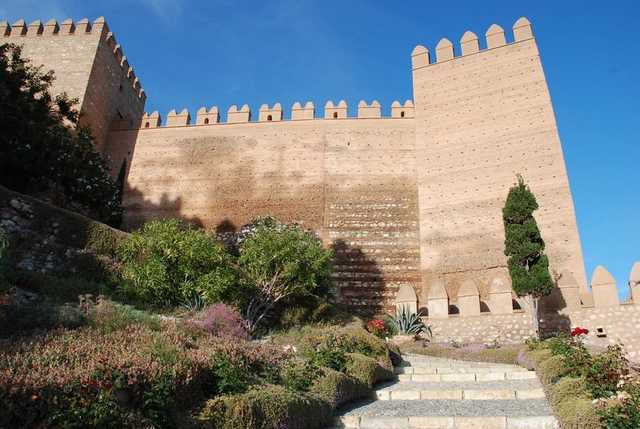The Alcazaba is located in an isolated elevation on which it dominates the city and bay of Almería, and stands out due to its capacity for defence and great visibility over the sea, reaching up to 55 km on clear days.
The fortress, together with the wall around the San Cristóbal hill, makes up one of the most amazing medieval defensive monumental ensembles of Al-Andalus.
The importance and complexity of its defences is due to the functions which it had as a dwelling and as a formal expression of the authority which governed a city of great economic and strategic importance during the Middle Ages, and which became the capital of a Taifa kingdom.
The Monumental Ensemble is currently divided into three enclosures: the first two are of Muslim design, and the third is of Christian origin.
The First Enclosure, constructed in the 40s by the Architect-Curator of the Alhambra in Granada, currently has landscaped gardens, although it originally had two dwelling areas and a cemetery.
The Second Enclosure is the main nucleus of the Alcazaba and forms a small palatial city equipped with all its buildings: cisterns, a mosque, public baths, houses and the palace, with a public and private area.
The Third Enclosure is a true Christian castle, constructed on a triangular floor, with circular towers and ashlars, as opposed to the square towers made of bricks and Muslim masonry.
The monument which currently exists is the product of more than one thousand years of history.
In 955, Abd al-Rahman III, the first caliph of Al-Andalus, granted the status of a city (madina) to Almería, ordered the construction of the Alcazaba, the Main Mosque and fortified the urban area between the fortress and shore.
Under his protection, Almería became the most important port in Al-Andalus; it became the base of the Ummayad navy and great battle-ships were constructed in its shipyards.
The excellent weather and strategic conditions of the site facilitated the settlement of sailors and dealers. Muslim texts speak of Almería as the best market place in Muslim Spain. Muslim merchants from Egypt and Syria and Christian merchants from France and Italy arrived at its port.
It achieved great economic and cultural development in the 11th century as a centre of trade relations with the Maghreb and Eastern Mediterranean countries.
This development was interrupted by the first Christian occupation of the city (1147-1157), which led to a decline which was never recovered. The definitive conquest came in 1489 by the Catholic Monarchs. From that time, a sea which had acted as a point of union between two shores became a dangerous frontier, where pirate attacks became frequent.
It was declared a Historical-Artistic Monument in 1931, at that time, still the property of the Ministry of War. From 1940, after it was transferred to the Ministry of Education, restoration works began as did works to equip the site for visits.
In 1989, the Department of Culture of the Junta de Andalucía, which, since the Autonomous government was formed, has held the property title of the monument and carried out its administration; created the"Monumental Ensemble of the Alcazaba"institution in order to guarantee the research, preservation and diffusion of this important legacy.
